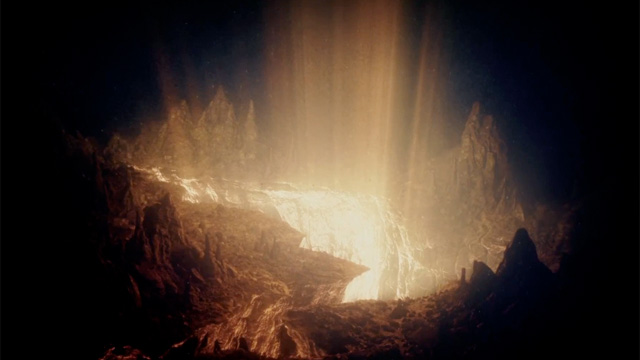
Pacific Rim is a hugely enjoyable (if flawed) film which does a better job than Michael Bay of putting giant robots on the big screen, while at the same time paying homage to Japanese monster movies and manga/anime series like Neon Genesis Evangelion. Although dominated by the awesome spectacle of towering machine men waging war against colossal sea-monsters, the film is also a good example of a subgenre of sci-fi/fantasy which I like to refer to as “gateway” fiction. In Pacific Rim, the monstrous Kaiju enter our universe through a portal deep under the Pacific ocean (hence the film’s title), a plot point which makes it the latest in a long line of fictitious works where the story revolves around a portal or gateway to another world. The notion of a magical/technological doorway which leads to unknown realms both beautiful and terrifying seems to fascinate us, so much so that it has been a recurring trope in our stories for thousands of years. But why should this be?
Gateway fiction has a long and illustrious history, the concept and imagery behind it stretching back at least as far as the biblical Book of Revelation, whose 4th verse describes “a door standing open in heaven”. A nice flip-side to this heavenly door is the malfunctioning teleporter in classic 1993 game Doom, which opens a portal to Hell itself (an idea recycled in the much underrated 1997 horror film Event Horizon), but there have been myriad other examples of the gateway in fiction across all media. One of the most famous is the titular piece of furniture in C.S. Lewis’ The Lion, The Witch and The Wardrobe, but consider also the transdimensional portal in Clark Ashton Smith’s influential 1931 story The City of Singing Flame, the network of interstellar gateways in the Stargate universe, the doorways to children’s bedrooms in Pixar’s Monsters Inc and the mouth of the wormhole which punctures New York’s skyline in Marvel’s recent Avengers movie. Often the gateway has been represented by a mirror, as in Lewis Carroll’s classic Alice Through the Looking-Glass, Grant Morrison’s meta-epic The Invisibles and John Carpenter’s 1987 film Prince of Darkness. The Argentine writer Jorge Luis Borges wrote at length about the unsettling nature of mirrors, showing as they do a reflected universe which can cause the viewer to question whether it is they or their reflection who truly exists (indeed, millions of words have been written about the mirror in fiction, but it is specifically their function as gateways which interests us here). Whether represented by a ghostly portal, a magic mirror or a simple doorway, the gateway is a device which has been used again and again in fiction throughout the ages, but why is it so popular with authors and film-makers?

Stargate
One has to wonder if the gateway holds a sort of primordial fascination for human beings, the origin of which can found in the darkened cave mouths of our ancestors’ time. Fanciful though this may seem, it is surely no accident that in Edgar Rice Burroughs’ A Princess of Mars, for example, the heroic John Carter’s interplanetary adventure truly begins when he enters a mysterious cave in the Arizona mountains. But whatever its origin as a fictional trope, the gateway is, simply put, a short-cut to the unknown. A world in which such a portal exists is one where terror, adventure, weirdness and wonder are just a few steps away; instead of being on the other side of the galaxy, or in a magical land beyond our understanding, that which is profoundly ‘other’ is in our very midst – simultaneously far beyond our reach and yet right in front of us. The gateway is an opening in an otherwise impenetrable and invisible barrier between our world and the fantastical, and as such can be both terrifying and alluring to the characters who encounter it. Most gateway stories thus feature protagonists who are unable to resist the urge to plunge into the unknown, intoxicated as they are by the proximity of the other.

Alice Through the Looking-Glass
The gateway’s presence as a physical object is also significant here. The solidity of the doorway emphasises that it is a part of our world as well as an entrance to another, thus reinforcing the dissonance caused when the distance between known and unknown is cut down to the depth of the gateway’s threshold. It reassures us about the mundanity of our own world, while at the same time confirming the existence and mind-bending strangeness of others, and can also operate as a failsafe when things go wrong; if cosmic horrors from a parallel dimension are pouring in through a magic door, the door can usually be closed somehow. The gateway can thus be a shield as well as a portal, and this offers still more storytelling possibilities for the device.
The gateway has been a common trope in sci-fi and fantasy fiction for centuries, and will doubtless continue to be so. This is both because of the unique storytelling possibilities it offers as a plot device, and also because of the potential it has to bring the ‘unreal’ crashing into the ‘real’ with unsettling effect. Pacific Rim is only the latest work of fiction to utilise the gateway, and demonstrates how it can not only provide an easy explanation for the presence of alien monsters, but also effectively suggest a universe more grand and grotesque than we could ever have imagined, lurking menacingly on the other side of the door.
